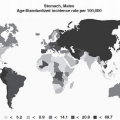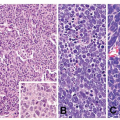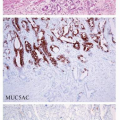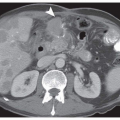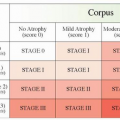INTRODUCTION
Properly staging cancer allows the clinician to choose the appropriate treatment modalities, reliably evaluate and predict outcomes of disease management, and uniformly document cancer cases worldwide. Although there are several classification systems for gastric cancer, the
Cancer Staging Manual developed by the American Joint Committee on Cancer (AJCC) with support from International Union for Cancer Control (UICC), the American Cancer Society, American College of Surgeons, American Society of Clinical Oncology, and International Union against Cancer is the generally accepted classification system.
1, 2 and 3 The cancer-staging criteria have been continually refined since 1959, with the combined efforts of medical community, and multiple medical and oncology organizations. The latest edition (7th edition) of the
AJCC Cancer Staging Manual was published in early 2010.
1 In the new edition, the AJCC and UICC used large datasets and emerging evidence to support changes in the cancer-staging criteria in general, and they used datasets from Asia, Europe, and the United States for the gastric cancer-staging systems in particular.
Because gastric cancer is a heterogeneous disease, attempts have been made to subclassify gastric cancers within a given tumor stage.
4, 5, 6, 7, 8, 9 and 10 A recent study of 1,056 patients with stage IV gastric cancer (diagnosed on the basis of the 6th edition of the
Cancer Staging Manual) divided patients into three groups on the basis of the tumor, node, metastasis (TNM) stage of their disease: group 1 (T4 N1-3 M0), group 2 (T1-3 N3 M0), and group 3 (T[any] N[any] M1).
11 The clinicopatho-logical characteristics, recurrence patterns, and survival rates of the three groups were compared. After R0 resection, locoregional recurrence (40.9%) followed by peritoneal recurrence (27.3%) was most common in group 1, whereas distant (30.2%) and peritoneal (26.7%) recurrence were most common in group 2. The 5-year survival rates in groups 1,2, and 3 were 18.3%, 27.1%, and 9.3%, respectively (
p < 0.001). Multivariate analysis showed that each subgroup had different clinical outcomes, including histological behavior, recurrence pattern, survival rates, and prognostic factors. Therefore, subclassification of stage IV gastric cancer into subgroups IVA (T1-3 N3 M0), IVB (T4 N1-3 M0), and IVM (T[any] N[any] M1) may provide a more accurate prediction of prognosis and selection of appropriate therapeutic options.
11 This study was among the data supporting the reclassification of the advanced gastric cancer, regrouping the IVA (T1-3 N3 M0) and IVB (T4 N1-3 M0) subgroups into stages IIB and III, respectively, leaving only the T[any] N[any] M1 subgroup in stage IV.
Since the past couple of decades, there are more gastric cancers in the proximal stomach now than there used to be.
12 Tumors of the esophagogastric junction (EGJ) may be difficult to stage as either a gastric or an esophageal primary tumor, especially as there is an increased incidence of
adenocarcinoma in the esophagus. The arbitrary 10-cm segment encompassing the distal 5 cm of the esophagus and proximal 5 cm of the stomach (cardia), with the EGJ in the middle, is an area of contention. Cancers arising in this segment have been variably staged as esophageal or gastric tumors, depending on the discretion of the treating physician.
13 In the new edition of the
AJCC Staging Manual, tumors arising at the EGJ, or arising within the proximal 5 cm of the stomach (cardia) that extends into the EGJ or esophagus, are staged using the TNM system for adenocarcinoma of the esophagus. All other cancers with a midpoint in the stomach lying >5 cm distal to the EGJ, or those within 5 cm of the EGJ but not extending into the EGJ or esophagus, are staged using the gastric cancer-staging system.
DEFINITIONS OF TNM
TNM staging describes three major anatomic characteristics of cancer: (a) the location and extension of the primary tumor, (b) the presence or absence of lymph node involvement, and (c) the presence or absence of distant tumor metastasis. These features can be evaluated by physical examination, imaging studies, and histopathologic evaluation. All cancers, though, should be confirmed histologically.
Clinical Staging and Pathologic Staging
Clinical staging, designated cTNM, is relied on evidence of the extent of disease before definitive treatment is started. Clinical staging includes physical examination, imaging, endoscopy, biopsy, and laboratory findings, which all establish the baseline stage. Imaging studies and endoscopy are most valuable tools in assessing clinical staging of gastric cancers (see
Chapters 6 and
19).
14, 15, 16 and 17Before pathologic staging, efforts should be made to differentiate primary gastric cancer from metastatic disease, which is not an uncommon event (see
Chapters 5 and
8). After the primary gastric cancer is established, gastric cancer should be classified. Majority of gastric cancer is adenocarcinoma. The histological subtypes of gastric cancer are listed in
Table 18-1 (also refer to
Chapter 5 for details).
Pathologically, the extent of the tumor needs to be carefully assessed. Pathologic staging depends on data acquired clinically together with findings on subsequent gross and microscopic examination of the surgically resected specimen.
Of note, the TNM-staging recommendations apply only to carcinomas. Lymphomas, sarcomas, and carcinoid tumors (well-differentiated neuroendocrine tumors) are excluded. Mixed glandular/neuroendocrine carcinomas should be staged using the gastric carcinoma-staging system for well-differentiated gastrointestinal neuroendocrine tumors.
Designation of Primary Gastric Cancer Status
Staging of primary gastric adenocarcinoma is dependent on the extension and depth of penetration of the primary tumor. Histologically, the wall of the stomach has five layers: mucosa, submucosa, muscular propria, subserosal connective tissue, and serosal surface (see
Chapter 1).
One of the major changes to the T designation for gastric cancer in the 7th edition of the
AJCC Cancer Staging Manual is that the T categories have been modified to correspond to the T categories for cancers of the esophagus and small and large intestines. Specifically, T1 lesions have been subdivided into T1a and T1b, which are defined as tumor invades muscularis mucosae and tumor invades submucosa, respectively; T2 is defined as a tumor that invades the muscularis propria; T3 is defined as a tumor that invades the subserosal connective tissue (formerly T2b in
AJCC Cancer Staging Manual, 6th edition); and T4 is defined as a tumor that invades the serosa (visceral peritoneum, formerly T3 in
AJCC Cancer Staging Manual, 6th edition) or adjacent structures.
18 The T (primary tumor) designation of gastric cancer is listed in
Table 18-2.



